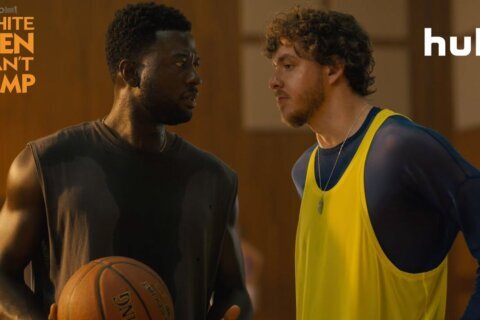Jason Fraley, WTOP film critic
WASHINGTON – In January, Clint Eastwood gave the nation a pep talk with a Super Bowl halftime ad. Last month, he spoke to a chair in a bizarre appearance at the Republican Convention.
Now, Clint gets back to business — the movie business — with the baseball flick “Trouble with the Curve.”
He plays Gus, an aging scout for the Atlanta Braves who’s losing his eyesight. He travels to North Carolina to scout a highly-touted high schooler, Bo Gentry (Joe Massingill), who can hit for power but has a fatal flaw. Little does Gus know, his job is on the line by a front office that wants to force him into retirement.
Gus’ longtime friend and colleague Pete (John Goodman) suspects Gus’ failing vision and asks Gus’ estranged lawyer daughter Mickey (Amy Adams) to be his eyes, applying the baseball knowledge she learned as a kid.
Joining the scouting trip in Carolina, Mickey finds romantic sparks with a Red Sox scout (Justin Timberlake) and tries desperately to reconnect with her impenetrable father.
As expected, Eastwood is back with the usual crotchety role we’ve seen since “Million Dollar Baby” (2004) and most recently in “Gran Torino.”
I’ve always liked Eastwood, from his “Good, Bad, Ugly” westerns to his “Dirty Harry” crime dramas, but I wonder whether now even his biggest fans are growing tired of his recent “get off my lawn” shtick.
The best performance comes from Amy Adams, who is equal parts tough and adorable as the emotionally unavailable daughter grappling with a “Cats in the Cradle” childhood. She may very well win a Supporting Actress Oscar this year for Paul Thomas Anderson’s “The Master” (2012), but “Trouble with the Curve” is the role that will keep her face familiar with mainstream audiences.
Adams seems to have mastered the mantra, “do one for the art, one for the fans.”
The idea of Adams and Timberlake quizzing each other with baseball trivia is a cute idea, and their near skinny dipping scene is well executed. Still, it’s hard to buy Timberlake as a former ballplayer.
J.T. pulled off Napster’s Sean Parker in “The Social Network” (2010) because he is a real-life music entrepreneur, moving from boy-band pop to catchy R&B, then investing in a musical MySpace.
In “Trouble with the Curve,” he tries being a reluctant jock amid a group of cloggers on a bar dance floor, when really we keep waiting for him to bust out dancing.
In addition to the three leads, the film has a deep bench of players to work with.
Viewers will recognize a number of the front office folks: John Goodman (“Roseanne”), Bob Gunton (“The Shawshank Redemption”), Robert Patrick (“Terminator 2: Judgment Day”), Chelcie Ross (“Major League”) and Matthew Lillard (“The Descendants”). The film also stars Eastwood’s son, Scott, as a promising young prospect who needs his parents in the stands to succeed.
The deep cast makes things easier for debut director Robert Lorenz, who uses out- of-focus lenses to simulate Clint’s failing eyesight and clever transitions like cutting from an office golf putter to a baseball in the outfield.
Lorenz goes way back with Eastwood, serving as an assistant director on “The Bridges of Madison County” (1995), “Absolute Power” (1997) and “Space Cowboys” (2000), before producing “Mystic River” (2003), “Million Dollar Baby” (2004), “Flags of Our Fathers” (2006), “Letters from Iwo Jima” (2006), “Gran Torino” (2008), “Invictus” (2009) and “J. Edgar” (2011).
Lorenz and debut screenwriter Randy Brown have the right instinct of letting the father-daughter relationship carry the film. I just wish they had more of a film to carry.
This movie doesn’t have “trouble with the curve.” It actually throws them quite well. After the “All is Lost” moment, the movie throws some fascinating curveballs in Act Three, both in the characters’ backstories and a unique climatic showdown. What the film lacks is an effective fastball for the first hour and a half. It’s like a closer who comes in and closes out the game well, but gets shelled when asked to pitch a full nine innings.
The story is formulaic, repetitive and many of the scenes predictable, rounding all the right bases, but lacking the danger and urgency of a Charlie Hustle.
My biggest gripe is with the handling of the cocky young prospect, Bo Gentry. The script succeeds in making him unlikable, but it tries too hard to make him that way, speaking unrealistic dialogue to his teammates about visualizing endorsement deals and scoring chicks.
Perhaps this is the disadvantage of coming a year after “Moneyball” (2011), an instant sports movie classic and one of my picks for The Top 10 Baseball Movies of All Time.
It’s impossible not to compare the two as Eastwood and Goodman debate the role of computers in the modern scouting process. And when you make that comparison, “Moneyball” screenwriters Steven Zaillan (“Schindler’s List”) and Aaron Sorkin (“The Social Network”) expose rookie Randy Brown for having a hitch in his swing. Break out the screenwriter soft toss. Surely this can be fixed.
If you have a father or daughter who loves baseball, or you’re simply an Eastwood fan, it may strike a personal chord for you. If not, I’d wait for it to come out on cable. When it comes to the recent lineup of sports movies, “Moneyball” was close to a .400 hitter, “The Blind Side” (2009) was a solid .300, and “Trouble with the Curve” is lucky to be hitting .250.
★ ★ 1/2
The above rating is based on a 4-star scale. Read more from WTOP Film Critic Jason Fraley by clicking Fraley on Film under the “Living” tab above, following @JasonFraleyWTOP on Twitter, and checking out his blog, The Film Spectrum.
(Copyright 2012 by WTOP. All Rights Reserved.)








